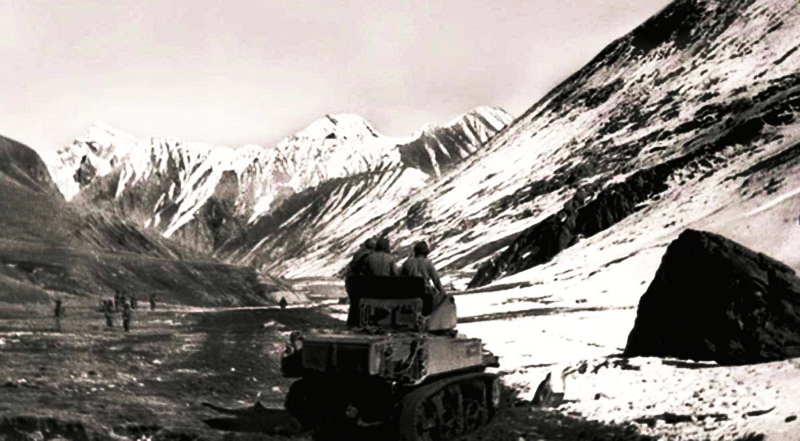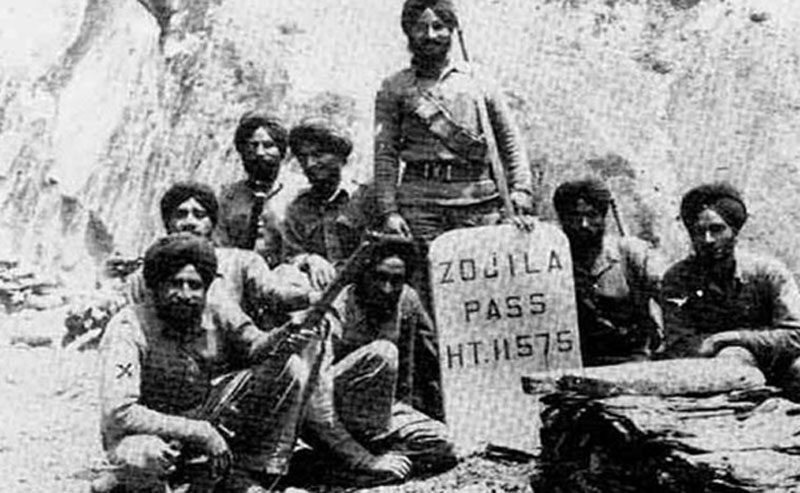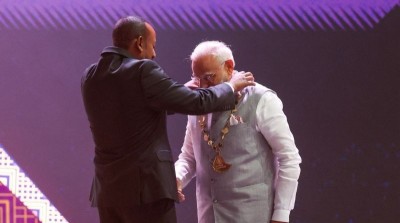 Zoji La
Zoji La
The use of tanks at Zoji La in 1948 turned the tide: former GoC N.S. Brar
India’s military history is full of important episodes that have shown the significance of leadership and tactical manoeuvring. The Battle of Zoji La in 1948 is one such episode that needs to be recalled for the brave decision to insert tanks into the battlefield.
The relevance of this operation in military terms was recently recalled by Lt. Gen. N.S. Brar, former GoC, 10 Corps Indian Army. Speaking at the Military Literature Festival in Chandigarh, Gen. Brar shed light on a pivotal chapter of the 1947-1948 war. He emphasized the strategic importance of the capture of Zoji La.
The pass, nestled on the Srinagar-Leh highway, played a crucial role in safeguarding Kargil, Dras, Leh, and Siachen. Without its capture by Indian forces, these territories would have been lost. Pertinently, the combination of armour and airpower had an impact on the course of battle. Despite scarce resources, the Indian Air Force(IAF) and Indian Army did wonders.
As Gen. Brar noted during his talk, the journey to capture Zoji La was far from easy. Two previous attempts to capture the pass had failed, and it wasn’t until the winter of 1948 that Indian forces managed to seize the pass. Notably, Gen. Brar underscored the outstanding contribution of the IAF during this operation.
At that time, the IAF had just one transport squadron with a mere three serviceable Dakotas, yet it played a vital role in airlifting men and equipment to Jammu and Kashmir.Tracing the history of the battle is easier today because the official history of the 1947-48 has been published and gives graphic detail of the Zoji La battle.
The setting of Operation ‘Bison’, was that in March 1948, Leh was threatened both from the north and the south by Pakistan Army regulars. Pakistan had occupied Zoji La, Dras and Kargil. Between Kargil and Leh, only two State Forces platoons, which guarded the bridge at Khaltse, stood in the way.According to the official history of the Kashmir War in 1947-48, the Leh detachment was ordered to build an airstrip near Leh in these difficult conditions, which they managed to complete by May 1948.
As Pakistani forces approached Khaltse, the J&K State Forces platoons demolished the bridge, halting the enemy in its tracks.On 1 June 1948, one company of 2/4 Gorkha Rifles was flown to Leh from Srinagar, to reinforce the Leh garrison. Leh still had no proper logistic support system. The route from Srinagar was blocked with the enemy occupying Zoji La, Drass and Kargil.
General K.S. Thimayyathen decided to re-take Zoji La, Drass and Kargil in a bold decision. The 77 (Para) Brigade commanded by Brig K.L. Atal was given the task of capturing Zoji La in September 1948.
This brigade comprised 3 JAT, 1/5 Gorkhas, 5 Maratha Light Infantry, a platoon of engineers, a platoon of machine gunners and a few ancillary units.1 Patiala, located at Baltal after clearing the Sonamarg valley, was put under command of the brigade.77 (Para) launched its action on 3 September 1948, but was unable to complete the mission. The difficult terrain and snow conditions on the heights surrounding Zoji La made any advance difficult.
Further, the Pak Army position was so strong that the Indian Army soldiers attacking Zoji La from the front could make no headway, “despite adequate artillery support and strafing of enemy positions by Tempest aircraft” of the IAF.
A second attempt was made on 13 September which too, failed. Gen.Thimayyathen put his ambitious plan to bring light armour into action into play with the objective of dislodging the enemy from Zoji La, and then head towardsDras and Kargil. Within a month, the Army Engineers (Madras Sappers) built a track that the Stuart tanks could use to reach the Pass from Baltal base.The plan also involved the move of a squadron located at Akhnoor across the PirPanjal Range.
The transportation of tanks from Jammu to Srinagar and beyond was one of the most formidable challenges as this marked the first instance in history that tanks were employed at such high altitudes. Bridges en route were unable to withstand their weight, prompting the troops to dismantle the tanks and reassemble them at the base of Zoji La.
The mule track leading to the pass was widened to accommodate these heavy war machines. That the tanks had to be winched across many bridges only added to the challenge.At that time, the Jammu-Srinagar road was a dusty track with weak wooden bridges over streams and rivers. Troops needed Engineer assistance at each crossing.To ensure that the movement of tanks was secret, tank turrets were removed and transported by vehicles.
 Photo courtesy: https://www.soldierstoryofkashmir.com/post/capture-of-zojila-pass
Photo courtesy: https://www.soldierstoryofkashmir.com/post/capture-of-zojila-pass
Turretless armoured vehicles, heavily camouflaged, moved under the cover of darkness.After nearly a month, the Stuarts finally arrived in the vicinity of Srinagar.
Zoji La usually sees the season’s first heavy snowfall towards the end of October, and 1948 was no exception. It started snowing on 20 October and ‘Operation Bison’ had to be postponed.Heavier snow was expected, but Gen.Thimayya declared 1 November as the next “D Day” — irrespective of the weather conditions.
Full credit must be given to Lt Col Rajinder Singh ‘Sparrow’, the CO of 7 Cavalry who “did not hesitate for a moment to accept this seemingly impossible mission”. During the assault, tanks were closely followed by infantry soldiers with bared bayonets.
The strategic decision to use tanks at this juncture turned the tide. Any hesitation intaking Zoji La would have resulted in the loss of Leh and Ladakh. Negotiating the tough terrain, which was steep and slippery amid heavy snowfall, the Stuart tanks reached the Ghumri basin on 1 November 1948.
The tank column followed by 1/5 (Royal) Gorkhas continued across the Pass, while 1 Patiala and 4 Rajput charged and drove out the enemy from their strongholds.The appearance of tanks came as a bolt from the blue for the Pakistani’s. Surprised and highly demoralised, the enemy ran for their lives. Gen.Thimayya ordered the Brigade Commander to press on to Machoi, a few kilometres ahead, and 1 Patiala reached their destination the same night. The surprised enemy had to once again run for their lives, this time leaving a howitzer behind.
With success in the pocket, the Army pushed further, and 4 Rajput captured Matyan, 18 km ahead of Zoji La, on 4 November.However, the advance was now held up by a very strong enemy position on dominating grounds. Once again, tanks were moved up to dislodge the enemy. By 15-16 November, Dras, the second-coldest inhabited place in the world, was captured.
The brigade resumed its advance on 17-18 November with Kargil as its main objective, and by the night of 22-23 November, all enemy positions on the way to Kargil were eliminated.A company of 5 Gorkhas took a long detour, crossed a feature more than 4,000 metres high, and contacted the Kargil defences at dawn.Another company of this battalion crossed the Shingo river and dealt a blow to the enemy from another direction. Later that day, a column from Leh effected the link-up at Kargil, which was finally cleared of the enemy, and the direct link from Leh to Srinagar restored.
Notably, Zoji La was captured just a day before the 1948 war ceasefire came into effect. This timely victory enabled India to retain control of territory that would otherwise have slipped into Pakistani hands. The Chandigarh session of the Military Literature Festival correctly highlighted the resilience, determination, and strategic brilliance that defined the capture of Zoji La, forever etching it in the annals of India’s military history.
Support Our Journalism
We cannot do without you.. your contribution supports unbiased journalism
IBNS is not driven by any ism- not wokeism, not racism, not skewed secularism, not hyper right-wing or left liberal ideals, nor by any hardline religious beliefs or hyper nationalism. We want to serve you good old objective news, as they are. We do not judge or preach. We let people decide for themselves. We only try to present factual and well-sourced news.





